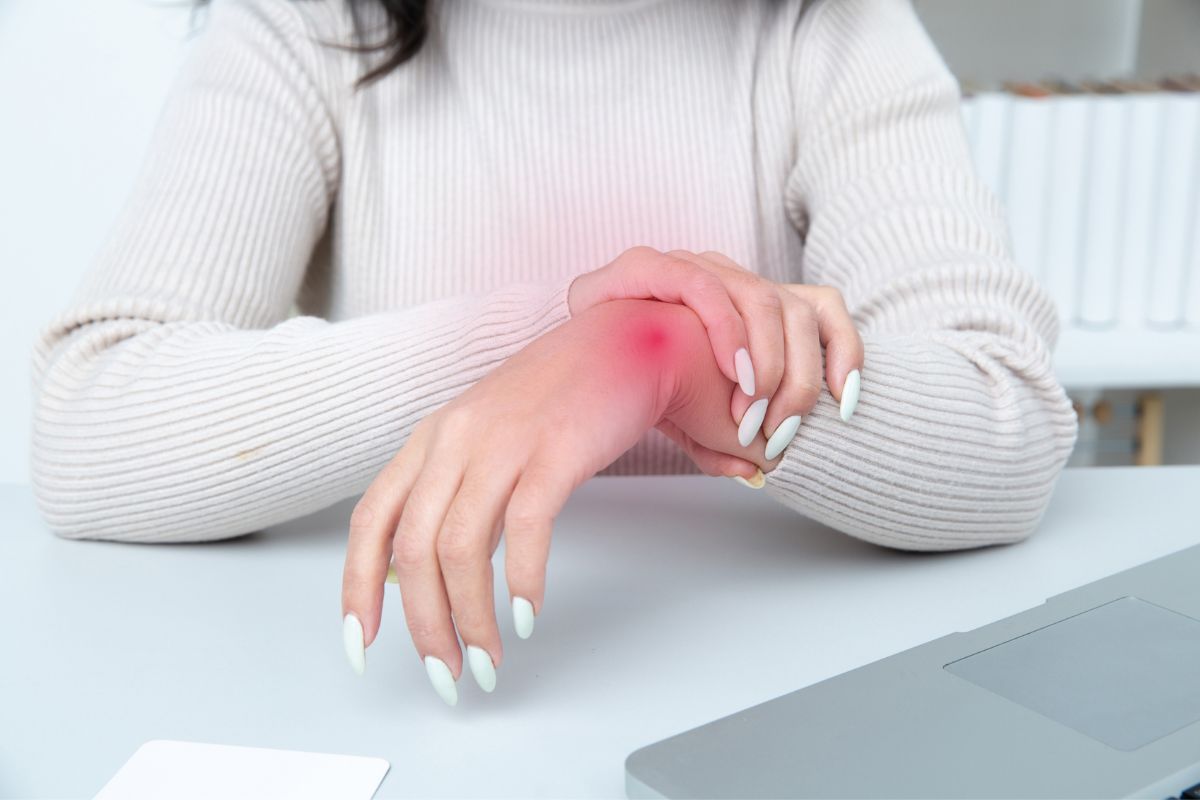Our hands have around 27 joints that work together to provide us with motion, we use our hands for so many daily and intricate tasks.

If any of these joints are affected in some way such as developing arthritis in one or more of the joints, then daily life can become quite difficult.
Developing arthritis can be so painful, and unfortunately there isn’t a cure for it, but it can be treated and managed.
In this article we will be discussing what arthritis is, the symptoms of it, the different types of arthritis and the potential treatments that can manage your arthritis.
What Is Arthritis?
Arthritis is not a single condition, there are many different types of it.
But in simple terms it refers to pain, stiffness or swelling of one or more joints and it can affect people of all ages and will also worsen with age, according to the CDC around 24% of US adults have arthritis.
The two most common types of arthritis are osteoarthritis and rheumatoid arthritis.
Osteoarthritis
This is the most common form of arthritis, it is a disease of the entire joint and can degrade cartilage, change bone shape and cause inflammation.
It generally affects older people and it is also seen to typically affect the hands, knees, hips, lower back and neck.
Rheumatoid Arthritis
This form of arthritis is an autoimmune disease, your immune system will mistakenly attack the cells which line your joints causing pain, swelling and stiffness.
Not only does it affect your joints, the inflammation from rheumatoid arthritis can also affect many other parts of your body such as the blood vessels, skin, eyes and heart.
It typically starts in the small joints of the hands and feet and causes swelling which can lead to bone erosion and joint deformity.
Symptoms Of Arthritis

Symptoms of arthritis of the hand can start in different ways, but most of the time the start of arthritis will feel like a dull or burning sensation in your hand.
Pain will also start if you have been using the joint a lot, the pain may not be immediate and some people will feel it in the morning.
It’s best to catch arthritis as early as you can, so if you start feeling these symptoms for a few days make sure to tell your doctor.
As the pain worsens, and things that were once easy like gardening or cleaning become harder to do, it may discourage you from doing these activities anymore.
Whilst you should rest if the pain becomes intense, you should definitely keep doing physical activity as it helps to maintain the health of your bones and joints.
Not doing any physical activity can worsen your condition in the long run.
Arthritis can also cause a grating or grinding sensation in the affected joint, this is when the cartilage has rubbed away, leaving the bone unprotected and this causes inflammation.
Cysts can also occur when arthritis affects the ends of the fingers, if you have one from arthritis you must inform your doctor to ensure more do not form.
Treatment
As we mentioned before, arthritis cannot be cured but it can definitely be treated and managed. There’s no reason to live in pain because you have arthritis.
Medications
Medication will help treat the symptoms of arthritis, but it can’t reverse any joint damage that has already occurred.
Your doctor will most likely prescribe you anti-inflammatories to stop the joint swelling and pain.
Steroids may also be used to slow the joint damage and treat the inflammation. Whatever you are prescribed will depend on how far your arthritis has developed.
Splinting
Splints are usually paired with injections, which will be administered if the anti-inflammatory drugs are not appropriate.
The splint is then applied which takes the stress off the affected joint and they are typically worn at times when the pain is bad and they allow functional use of the hand so you can continue to go about your daily activities.
Surgical Treatment
If all else fails, then surgical treatment may be suggested.
Surgical treatment should only be considered if it will provide long-term pain relief and proper function to return to the hand.
Arthritis surgery can replace or help repair a damaged joint.
If the joint is being replaced then a prosthesis will be inserted in the place of the joint which can consist of materials like metal, ceramic or plastic and this type of surgery can be done on most of the joints of your hand and wrist.
This surgery will improve the function of the affected area and to reduce joint pain to ultimately boost your quality of life.
When the joint is salvageable but there is severe joint damage, a joint fusion may be opted for.
A surgeon will use pins, plates or rods to join two or more bones together and over time hopefully the joints will grow together and lock in place.
They provide relief but the fused joint can have a reduced range of mobility and this treatment can put stress on surrounding joints which can lead to more pain occurring and arthritis potentially developing in different joints of the affected area.
Final Thoughts
Arthritis is an immensely painful condition that can severely affect a person’s quality of life.
If you experience any symptoms it’s best to go to a doctor as soon as possible, as the earlier you catch it the easier it will be to manage.
Treatment is the best option for arthritis, if it’s left untreated then joint deformity and permanent damage to the joint can occur.
Whatever stage your arthritis is in and how far it has progressed will determine what type of treatment will be best for you, but medication will most likely be key to stop the inflammation, pain and swelling of the joint.
Surgical treatment may be viable, but it all depends on each individual case of arthritis, and how deteriorated the joint is.
- Understanding Male Reproductive Health: A Complete Guide - February 2, 2025
- Simple Healthy Skin Habits for Radiant Skin - December 6, 2024
- Unlocking the Connection Between Nutrition and Mental Health - December 3, 2024








